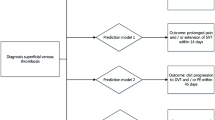Abstract
Post-thrombotic syndrome (PTS) has variable clinical presentation with significant treatment costs and gaps in the evidence-base to support clinical decision making. The contribution of variations in venous anatomy to the risk of complications following treatment has yet to be characterized in detail. We report the development of a steady-state, 0D model of venous anatomy of the lower limb and assessments of local sensitivity (10% radius variation) and global sensitivity (50% radius variation) of the resulting flows to variability in venous anatomy. An analysis of orthogonal sensitivity was also performed. Local sensitivity analysis was repeated with four degrees of thrombosis in the left common iliac vein. The largest normalised sensitivities were observed in locations associated with the venous return. Both local and global approaches provided similar ranking of input parameters responsible for the variation of flow in a vessel where thrombosis is typically observed. When a thrombus was included in the model increase in absolute sensitivity was observed in the leg affected by the thrombosis. These results can be used to inform model reduction strategies and to target clinical data collection.
Access this chapter
Tax calculation will be finalised at checkout
Purchases are for personal use only
Similar content being viewed by others
References
Stone, J.: Deep vein thrombosis: pathogenesis, diagnosis, and medical management. Cardiovasc. Diagn. Ther. 7(3), 276–284 (2017)
Baldwin, M.J.: Post-thrombotic syndrome: a clinical review. J. Thromb. Haemost. 11(5), 795–805 (2013)
Beckman, M.G.: Venous thromboembolism: a public health concern. Am. J. Prev. Med. 38(4), 495–501 (2010)
Lim, C.S., et al.: A centralised complex venous service model in an NHS hospital. Br. J. Healthcare Manag. 26(2), 2–15 (2022)
Black, S.A., et al.: Management of acute and chronic iliofemoral venous outflow obstruction: a multidisciplinary team consensus. Int. Angiol. 39(1), 3–16 (2020)
Shi, Y., et al.: Review of zero-D and 1-D models of blood flow in the cardiovascular system. Biomed. Eng. Online 10, 33 (2011)
Müller, L.O., Toro, E.F.: A global multiscale mathematical model for the human circulation with emphasis on the venous system. Int. J. Numer. Meth. Biomed. Eng. 30, 681–725 (2014)
Keijsers, J.M., et al.: A 1D pulse wave propagation model of the hemodynamics of calf muscle pump function. Int. J. Numer. Method Biomed. Eng. 31(7), e02716 (2015)
Huberts, W., et al.: What is needed to make cardiovascular models suitable for clinical decision support? A viewpoint paper. J. Comput. Sci. 24, 68–84 (2018)
Benemerito, I., et al.: Determining clinically-viable biomarkers for ischaemic stroke through a mechanistic and machine learning approach. Ann. Biomed. Eng. (2022). https://doi.org/10.1007/s10439-022-02956-7
Li, R., et al.: Selection of model parameters for off-line parameter estimation. IEEE Trans. Control Syst. Technol. 12(3), 402 (2004)
Saltelli, A., et al.: Variance based sensitivity analysis of model output. Design and estimator for the total sensitivity index. Comput. Phys. Commun. 181(2), 259–270 (2010)
Hose, D.R., et al.: Cardiovascular models for personalised medicine: where now and where next? Med. Eng. Phys. 72, 38–48 (2019)
Acknowledgements
This publication is supported by the European Union’s Horizon 2020 research and innovation programme under grant agreement Sano No 857533 and carried out within the International Research Agendas programme of the Foundation for Polish Science, co-financed by the European Union under the European Regional Development Fund.
Author information
Authors and Affiliations
Corresponding author
Editor information
Editors and Affiliations
Rights and permissions
Copyright information
© 2022 The Author(s), under exclusive license to Springer Nature Switzerland AG
About this paper
Cite this paper
Otta, M., Halliday, I., Tsui, J., Lim, C., Struzik, Z.R., Narracott, A. (2022). Sensitivity Analysis of a Model of Lower Limb Haemodynamics. In: Groen, D., de Mulatier, C., Paszynski, M., Krzhizhanovskaya, V.V., Dongarra, J.J., Sloot, P.M.A. (eds) Computational Science – ICCS 2022. ICCS 2022. Lecture Notes in Computer Science, vol 13352. Springer, Cham. https://doi.org/10.1007/978-3-031-08757-8_7
Download citation
DOI: https://doi.org/10.1007/978-3-031-08757-8_7
Published:
Publisher Name: Springer, Cham
Print ISBN: 978-3-031-08756-1
Online ISBN: 978-3-031-08757-8
eBook Packages: Computer ScienceComputer Science (R0)




